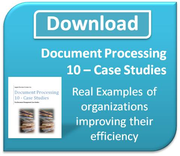When I started in the Document Management field the common term for the practice of capturing paper records and converting them to digital images was simply document imaging. While the process involved in doing the conversion seems pretty simple in today's terms back twenty some years ago it was seen as a miraculous change in office environments.
By using high speed (and relatively expensive) scanners paper documents were copied electronically and then using sophisticated software converted to images for filing. The most common image format at the time was TIFF and the i mages were simple black and white format captures. The computer horsepower required was well beyond what a typical workstation could handle and the process was usually dedicated to a scanning department who handled the paper setup, scanning and the file indexing into the document imaging software. Over the years many things have changed including the software which is used for handling document filing. Document management has evolved into a much more robust and substantial framework which has impacts throughout the organization.
mages were simple black and white format captures. The computer horsepower required was well beyond what a typical workstation could handle and the process was usually dedicated to a scanning department who handled the paper setup, scanning and the file indexing into the document imaging software. Over the years many things have changed including the software which is used for handling document filing. Document management has evolved into a much more robust and substantial framework which has impacts throughout the organization.
Another step along the continuum of information management has been dubbed Information Governance. The idea here is that things beyond the legally required documents of an organization need to be captured, stored and made available for subsequent use. Traditionally, things stored in a filing system or a document management system have been mostly items which are legally required either for legislative reasons or for accounting reasons.
Information governance goes beyond such items as electronic file storage for retrieval purposes and expands to include all of the native knowledge which is key to the business. Information governance is the process of encoding the procedures and steps to manage this capability including the ability to structure the eventual destruction of information no longer needed. This is a step which is too often left to chance and which can lead to long term issues if not built into the process from the beginning.
In a recent blog post for the Ingrammicro Advisor a five step process for adopting the information governance model is articulated. It gives a good summary of the steps needed to be considered making the case for starting small in a test environment and expanding the development of a full blown process from there. While the focus of the blog is towards the document imaging vendor who is looking at expanding their practice to a broader base, the steps are of value to end users as well.
This starting with a controlled or departmental implementation is a practice which many successful organizations deployed in the early days of document imaging and it has great merit as it helps to build the case and value for the processes when change is considered.
One of the things which this consideration reinforces for me is that business processes dealing with the inherent knowledge within an organization can never become stagnant. It is necessary to be constantly looking at how processes can be refined and improved over time. Sometimes it takes a fairly major process analysis and plan. At other times it involves a less sophisticated but just as important iterative ongoing change review.
Information governance is a logical extension of the many years of work in refining industry standards as they relate to document and information structures. Looking at what elements should be considered as part of a business planning cycle is a good place to start.
Lee K




